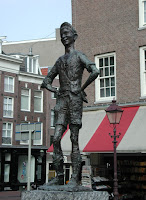Because my first meeting with Beuys as a scholar was in connection with my research on Fluxus, this is where I started. It ought to be easy to deal with Beuys and Fluxus. If you apply the strictest of criteria, Beuys only participated in one Fluxus festival, the Festum Fluxorum Fluxus at the art academy in Düsseldorf on 2-3 February 1963, and of the two pieces he presented there, he only considered one to be a “Fluxus” piece. So: one festival, one work. But what, then, about the exhibition Joseph Beuys Fluxus at the Haus Van der Grinten in Kranenburg in November 1963? If you go by the title, all the works on display there ought to be Fluxus works, but some of them predate Fluxus by several years. There is even one drawing, Fluxus für Vierzehnjährige ("Fluxus for Fourteen-year-olds"), that is dated 1948/9. And Beuys’s engagement with Fluxus extends way beyond the early 1960s as well: think, for example, of his and Ken Friedman’s multiple Fluxus Zone West/Fluxus West from 1971. In the case of Beuys, Fluxus is both a very narrow and a very broad concept.
Laws – in this case the simple one-after-the other of time – seem to work differently with Beuys. The notion of the reservoir, which he unfolded in his Infiltration-homogen für Konzertflügel ("Infiltration-homogen for Concert Piano"), is a useful one to explain how. The Infiltration-homogen, an action performed at the art academy in Düsseldorf on 28 July 1966, revolved around a concert piano with a felt cover. The felt, Beuys has said, turned the piano into a “Klangdepot”, a sound reservoir. All the sounds that the piano can and will produce, are trapped inside the felt skin, without order, earlier and later sounds, real and potential sounds mixed together. The idea is echoed by the felt itself: the fibres it consists of are not woven, but matted. Felt is a homogeneous material. In Beuys’ work, felt is associated with isolation, warmth and absorption. Beuys draws on direct bodily knowledge about felt that we all have, which is one of the ways in which he communicated. But what is more important here is that each and every one of Beuys’ works, and indeed his oeuvre as a whole, can be seen Depote, reservoirs, felt-like in their structure.
Within the single work, there are always numerous layers and kinds of meaning. In Infiltration-homogen, the experiential knowledge we all have of felt is combined with the conventional sign of the Red Cross, stitched on the side of the piano cover - for Beuys a sign of “emergency” - and a contemporary reference: the subtitle of the Aktion was der grösste Komponist der Gegenwart ist das Contergankind, “the greatest contemporary composer is the thalidomide child”. The drug thalidomide had been taken off the market only five years earlier because it caused serious deformities in unborn foetuses, especially deformed limbs. The crippled child echoes the isolated piano as a container that nothing can get out of. But despite the many things Beuys has said about his work, you cannot compile a Beuys dictionary. Every line you draw through the homogeneous mass of references – the reservoir – gives a particular reading, but you cannot say that any single reading is the correct one. And the same can be said of his dating. If he includes a drawing from 1948 in a Fluxus exhibition, it is to invite the visitor to think about Fluxus. To Beuys, Fluxus was a principle rather than a group of people or a type of work. Flux, later Hauptstrom/”main stream”: flowing.
Beuys’ work was about setting in motion, about abolishing fixed categories. He is perhaps best known for the term “social sculpture” and the slogan “everyone is an artist”. Sculpture means changing things. A felt corner changes the right angles of a room. A thought can change society. It is not surprising that Beuys became politically active. The Deutsche Studentenpartei (German Student Party) was founded in his class at the Düsseldorf art academy in 1967. In 1970, he founded the Organisation der Nichtwähler, Freie Volksabstimmung (Organisation for Non-Voters and Free Referendum). Renamed the Organisation für direkte Demokratie durch Volksabstimmung (Organisation for Direct Democracy through Referendum), it was present at Documenta V in 1972, with Beuys discussing his works and politics with the audience for the full 100 days that the exhibition lasted. In 1977, at Documenta 6, he installed his Honigpumpe am Arbeitsplatz (“Honey Pump in the Workplace”), an image of ideas flowing through the social organism. An integral part was the presence of the Freie internationale Universität (Free International University), by means of 13 workshops on contemporary issues such as nuclear power, the effects of capitalism, et cetera.
Beuys’ work and politics became increasingly inseparable – but they are miles apart as well. His theories, such as the Energy Plan for the Western Man from 1974, dealt with society and how to change it. His work, on the other hand, is recognizable as artwork, with a distinct style and an often unique character. It is also extremely puzzling. As a viewer, you’ll want an explanation, but the nature of the explanations, of the available keys, varies enormously, from knowledge that we all carry in our own bodies to abstract theories offered by Beuys. That, to my mind, is the greatest challenge Beuys’s work offers to the scholar and the viewer: to balance all of these explanations.
- More Beuys to follow -

